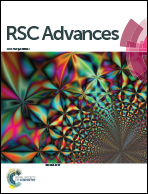Kinetic resolution of secondary alcohols with Burkholderia cepacia lipase immobilized on a biodegradable ternary blend polymer matrix as a highly efficient and heterogeneous recyclable biocatalyst†
Abstract
The present work reports a highly efficient and biocatalytic heterogeneous protocol for kinetic resolution (KR) of racemic secondary alcohols with vinyl acetate as an acyl donor, using the biocatalyst Burkholderia cepacia lipase (BCL) immobilized on a biodegradable ternary blend support through polylactic acid (PLA)/polyvinyl alcohol (PVA)/chitosan (CHI); (PLA/PVA/CHI–BCL). The KR reaction with various substituted aromatic, heterocyclic racemic secondary alcohols gave enantiomerically pure alcohol and its enantioenriched acetate derivatives with high conversion (45–50%) and excellent enantiomeric excess (up to 99% ee) at optimized reaction conditions. The reaction works under mild conditions using simple and inexpensive starting materials such as racemic alcohols, vinyl acetate, and immobilized biocatalyst. The given protocol provides excellent recyclability with good yield and enantiomeric excess values up to the studied range of five cycles. The resultant products were characterized with the help of different analytical techniques such as 1H and 13C-NMR, chiral HPLC column, polarimeter, IR and GC-MS.


 Please wait while we load your content...
Please wait while we load your content...